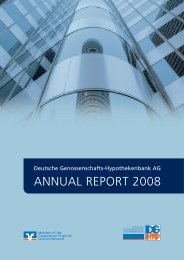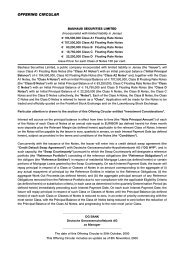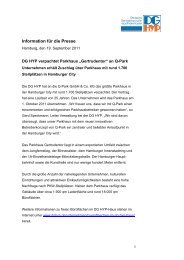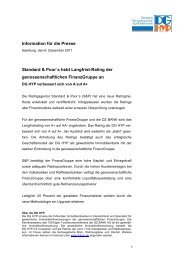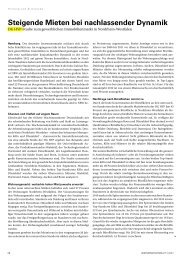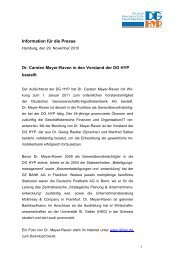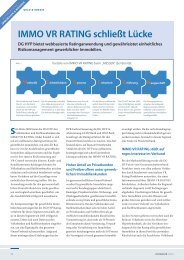Covered Bonds - DG Hyp
Covered Bonds - DG Hyp
Covered Bonds - DG Hyp
Create successful ePaper yourself
Turn your PDF publications into a flip-book with our unique Google optimized e-Paper software.
<strong>DG</strong> HYP COVERED BONDS – PFANDBRIEFE – QUALITY THE PATH OUT OF THE CRISIS SPECIAL MAY 2009<br />
are confident that the „pfandbrief“ brand would promote solidarity support – either in the<br />
form of other banks declaring their willingness to take over the cover pool lock, stock and<br />
barrel, or at the very least assisting the collateral receiver/manager’s efforts to bridge lastminute<br />
liquidity shortfalls. One has to fear however that this solidarity would be severely<br />
constrained should several banks get into difficulty at the same time. The other issuers‘<br />
absorption capacity or financial discretion would be exhausted beyond a certain level.<br />
Who will sit with whom – and when?<br />
A more technical issue that has been concerning the market for some time in relation to the<br />
role of collateral receiver/manager, is what basic conditions need to apply for the appointee<br />
to perform the function. The revision of the regime has at least brought some enlightenment.<br />
Paragraph 31 (8) says, „the collateral receiver/manager is empowered to call on the<br />
pfandbrief bank‘s personnel and material resources in order to perform his functions. He<br />
shall reimburse the bankrupt estate for the actual costs incurred“. This new formulation at<br />
least makes it clear what resources the collateral receiver/manager has at his disposal<br />
when taking up the task. However, it still leaves some questions open (which admittedly are<br />
hard for the law to specifically resolve): how long will it take for the collateral<br />
receiver/manager to be ready to start work? What happens to the cover pool during this<br />
period; especially, when payments are due? It is not known for instance whether BaFin has<br />
already drawn up lists of names of potential collateral receivers/managers. And how does<br />
one assess someone’s suitability for the role of collateral receiver/manager anyway? These<br />
questions admittedly appear too trivial at first glance to be truly relevant. However, the<br />
eventuality of a jumbo-issuer’s insolvency would leaves huge volumes of cover assets<br />
needing management; this is just one example of a case where the very suitability of a<br />
collateral receiver/manager to perform the task to creditors‘ satisfaction, would be a central<br />
fundamental issue.<br />
It will take a real‐life case to teach reliable lessons<br />
To be totally honest: it will only be possible to state definitively whether the appointment of a<br />
collateral receiver/manager will really guarantee the prompt servicing of pfandbrief creditors<br />
in the issuer-insolvency scenario when we have actually experienced this eventuality. And<br />
while we naturally hope never to see this sad day, at the same time we are confident that<br />
we will not have to do so within the foreseeable future.<br />
One important issue that we believe was omitted in error from the pfandbrief law revision<br />
agenda, is the option of issuing new pfandbriefe – including after the bank has filed for<br />
insolvency protection. This option would give the collateral receiver/manager new discretion<br />
that goes way beyond the scope of the powers defined in the revised regime. In fact, it is not<br />
entirely clear whether the current version of the law might not provide for this already,<br />
though the general view is that this is not possible at present. A detailed formulation on this<br />
issue would at least have helped the market.<br />
Revision of the Pfandbrief Banks Act<br />
The revised version of the Pfandbrief Banks Act (PfandBG) took legal effect on the<br />
promulgation of the Bill to Further Improve Pfandbrief Law in the Federal Gazette of 26<br />
March 2009. The provisions of the new §4.1a PfandBG extending the required liquidity<br />
cushion from 90 to now 180 days will only apply from 1 November 2009. The following table<br />
recaps the key changes to the PfandBG.<br />
Revision of pfandbrief law brings<br />
only limited clarity<br />
New issues – even post‐insolvency –<br />
would increase flexibility<br />
29





